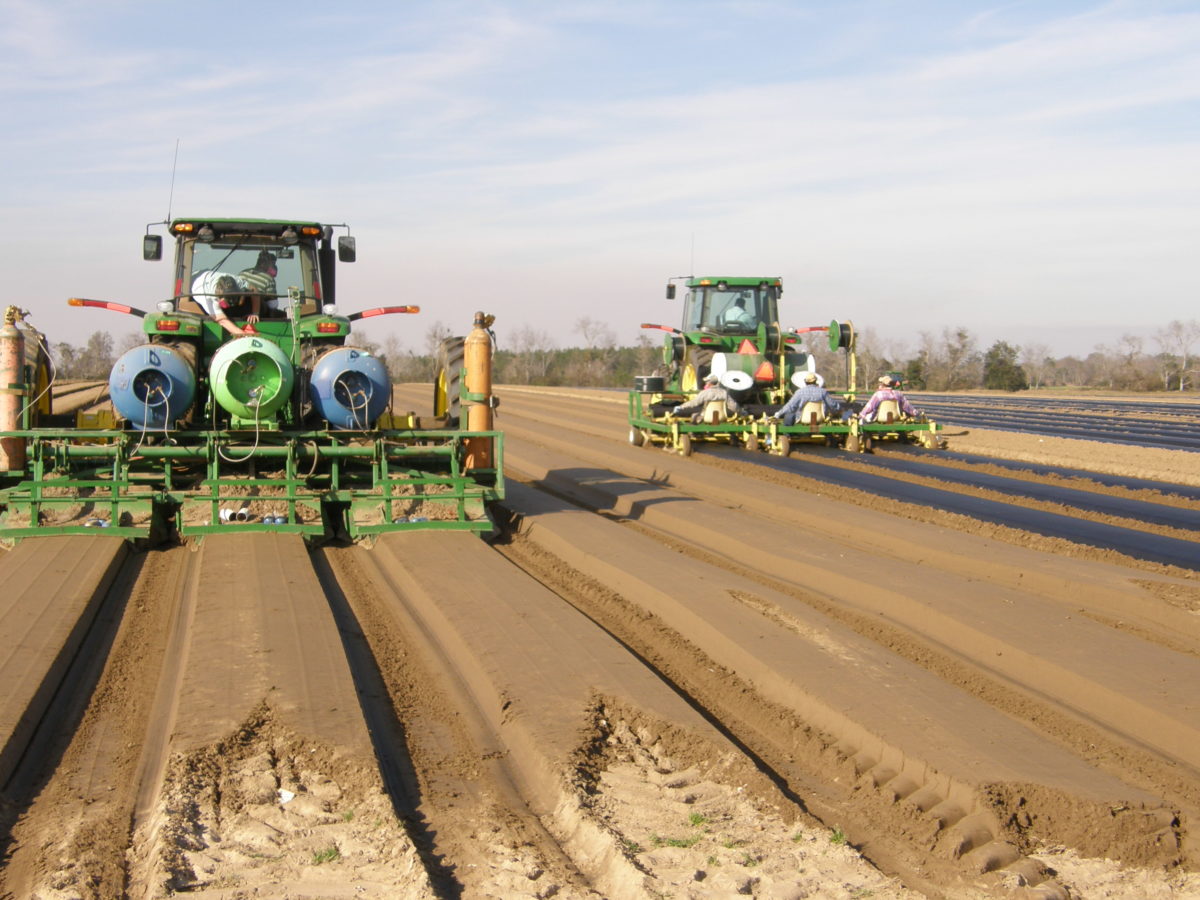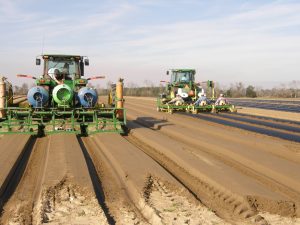By Jenna C. Vance and Stanley Culpepper
Effective alternatives to methyl bromide do exist for fruiting vegetable and cucurbit cropping systems in the Southeast; albeit these alternatives are much more complex than in the “golden” methyl bromide days. Growers need to be much smarter and more efficient in their decision-making process, and they need to better understand the factors that are critical in preventing the fumigant from escaping the treated bed.
Soil texture, soil moisture, soil temperature, bed compaction and mulch selection will greatly influence the success or failure of any fumigant system. A grower’s goal for a successful fumigation with new systems is to manipulate these factors as much as possible to extend the period of time a given pest is entrapped by an effective fumigant at a high enough concentration to maximize control. For example, the goal in Georgia with a winter fumigant application is to keep several of the key fumigant products in the bed for up to four weeks, which often ensures success. Of course, summer applications are far more challenging, but using cultural practices to extend the life of the fumigant will result in better success.
FUMIGANT SYSTEM OPTIONS
Selecting the ideal fumigant, mulch and herbicide program is challenging. University of Georgia (UGA) research has noted there are three options growers should consider in regard to fumigant systems. First, the UGA 3-Way includes Telone II, chloropicrin and metam sodium (Vapam, etc). Telone II is often injected 14 to 18 inches deep followed by chloropicrin injected evenly across the bed at 8 to 10 inches deep (at least three knives for a 32-inch-wide bed top). Metam sodium, the key for weed control in the system, is placed in the final bed with injection points 4 inches apart as well as 4 inches below the final bed top. This system provides good to excellent control of common weeds and excellent control of nematodes.
Telone II and chloropicrin are often replaced with Pic-Clor 60, but less nematode control is to be expected. Low-density polyethylene mulch is effective with this system for loamy sand soils during spring (cool soil) fumigation of fields lightly infested with nutsedge. Totally impermeable film (TIF) is a more effective option for controlling nutsedge on sandy soils or fields with a heavy nutsedge infestation. TIF is also a better option with the UGA 3-Way for summer (warm/hot soils) fumigation.
Paladin-Pic is a mixture of dimethyl disulfide and chloropicrin most often in a 79:21 ratio. This mixture is injected 8 to 10 inches below the bed top and covered with TIF mulch. It is effective in controlling nutsedge, but provides only fair to poor control of annual grasses and broadleaf weeds. Adding metam sodium to the system following the same process as noted above in the UGA 3-Way system is suggested for these weeds. If metam sodium is not included, then a program applying herbicides under mulch is likely needed. Paladin has a distinct odor, and applicators must be careful to avoid off-target odor issues.
Pic-Clor 60 applied under TIF can be another effective option, although clearly not as consistently effective as the Paladin-Pic + metam or the UGA 3-Way system. This system is ideal when the grower plans to produce only one to two crops prior to mulch removal, and the crops grown (such as tomato or cucumber) allow topical Sandea applications. The fields to which this fumigant system is applied should have light nutsedge and nematode infestations. The addition of an herbicide program should also be considered.
HERBICIDES UNDER MULCH
Herbicides are often not needed under mulch when applying metam sodium, except in fields that are heavily infested with weeds. Herbicides are often beneficial when applied under the mulch correctly; however, they simply are not as effective under mulch as compared to bare-ground applications. Also, keep in mind that herbicide carryover is much longer with most herbicides applied under mulch. If applying an herbicide under mulch, the herbicide spray must be made on the soil after the final bed is formed, which includes the laying of the drip tape prior to the application. It is critical that the treated bed not be disturbed after laying mulch.
ROW-MIDDLE WEED CONTROL
Interestingly, over the past few years, growers are having more and more issues with weed species such as purslane and pigweeds. When evaluating many of these issues, the problem actually arises from poor row-middle weed control. These pests produce an enormous amount of seed, and as the population initially builds from lack of row-middle control, it will eventually reach the point where the fumigant/herbicide system under the mulch providing >95 percent control is not adequately effective. Effective row-middle herbicides are available and should be used, but remember managing the weed seed bank (especially nutsedge, purslanes and pigweeds) is a 365-day-a year job requiring efforts before, during and after producing the crop.
Jenna C. Vance is a crop and soil sciences research professional and Stanley Culpepper is a professor and Extension weed scientist, both at the University of Georgia.
See more articles like this in VSCNews magazine. Visit VSCNews.com/subscribe/ today.
Share this Post











